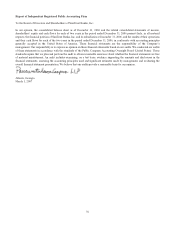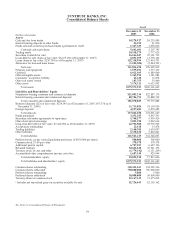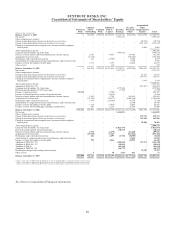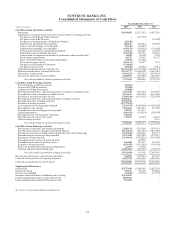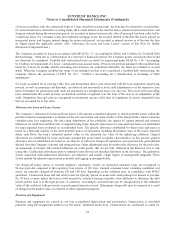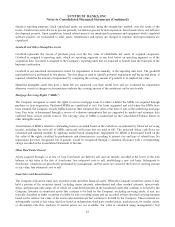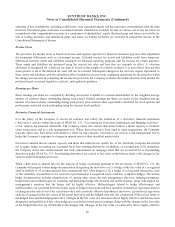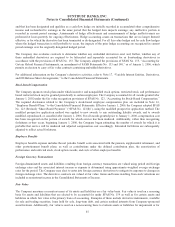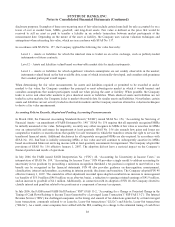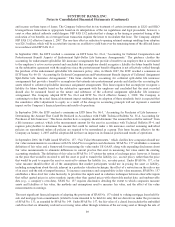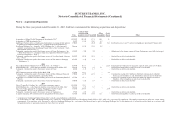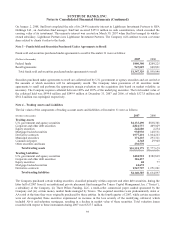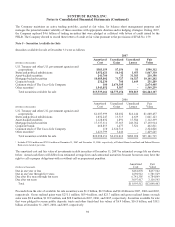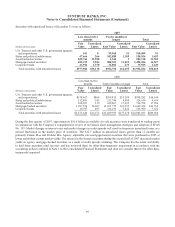SunTrust 2007 Annual Report Download - page 98
Download and view the complete annual report
Please find page 98 of the 2007 SunTrust annual report below. You can navigate through the pages in the report by either clicking on the pages listed below, or by using the keyword search tool below to find specific information within the annual report.SUNTRUST BANKS, INC.
Notes to Consolidated Financial Statements (Continued)
estimates of key assumptions, including credit losses, loan repayment speeds and discount rates commensurate with the risks
involved. Unrealized gains and losses on retained interests classified as available for sale are shown, net of any tax effect, in
accumulated other comprehensive income as a component of shareholders’ equity. Realized gains and losses on available for
sale or trading securities and unrealized gains and losses on trading securities are recorded in noninterest income in the
Consolidated Statements of Income.
Income Taxes
The provision for income taxes is based on income and expense reported for financial statement purposes after adjustment
for permanent differences such as tax-exempt income. Deferred income tax assets and liabilities result from temporary
differences between assets and liabilities measured for financial reporting purposes and for income tax return purposes.
These assets and liabilities are measured using the enacted tax rates and laws that are currently in effect. A valuation
allowance is recognized for a deferred tax asset if, based on the weight of available evidence, it is more likely than not that
some portion or all of the deferred tax asset will not be realized. Subsequent changes in the tax laws require adjustment to
these assets and liabilities with the cumulative effect included in income from continuing operations for the period in which
the change was enacted. In computing the income tax provision, the Company evaluates the technical merits of its income tax
positions based on current legislative, judicial, and regulatory guidance.
Earnings per Share
Basic earnings per share are computed by dividing net income available to common shareholders by the weighted-average
number of common shares outstanding during each period. Diluted earnings per share are based on the weighted-average
number of common shares outstanding during each period, plus common share equivalents calculated for stock options and
performance restricted stock outstanding using the treasury stock method.
Derivative Financial Instruments
It is the policy of the Company to record all contracts that satisfy the definition of a derivative financial instrument
(“derivative”) and are within the scope of SFAS No. 133, “Accounting for Derivative Instruments and Hedging Activities,”
at fair value in the financial statements. The Company enters into various derivatives both in a dealer capacity to facilitate
client transactions and as a risk management tool. Where derivatives have been used in client transactions, the Company
typically enters into derivatives with dealers to offset its risk exposure. Derivatives are used as a risk management tool to
hedge the Company’s exposure to changes in interest rates or other identified market risks.
Derivatives entered into in a dealer capacity and those that either do not qualify for, or for which the Company has elected
not to apply, hedge accounting are accounted for as free standing derivatives. In addition, as a normal part of its operations,
the Company enters into certain interest rate lock commitments on mortgage loans that are accounted for as freestanding
derivatives under SFAS No. 133. Freestanding derivatives are carried at fair value on the balance sheet, with changes in fair
value recorded in noninterest income.
When a derivative is entered into for the purpose of hedge accounting pursuant to the provisions of SFAS No. 133, the
Company will prepare written hedge documentation designating the derivative as (1) a hedge of the fair value of a recognized
asset or liability or of an unrecognized firm commitment (fair value hedge) or (2) a hedge of a forecasted transaction, such
as, the variability of cash flows to be received or paid related to a recognized asset or liability (cash flow hedge). The written
hedge documentation includes identification of, among other items, the risk management objective, hedging instrument,
hedged item and methodologies for assessing and measuring hedge effectiveness and ineffectiveness, along with support for
management’s assertion that the hedge will be highly effective. Methodologies related to hedge effectiveness and
ineffectiveness are consistent between similar types of hedge transactions and have included (i) statistical regression analysis
of changes in the cash flows of the actual derivative and a perfectly effective hypothetical derivative, (ii) statistical regression
analysis of changes in the fair values of the actual derivative and the hedged item and (iii) comparison of the critical terms of
the hedged item and the hedging derivative. Changes in the fair value of a derivative that is highly effective and that has been
designated and qualifies as a fair value hedge are recorded in current period earnings, along with the changes in the fair value
of the hedged item that are attributable to the hedged risk. Changes in the fair value of a derivative that is highly effective
86


